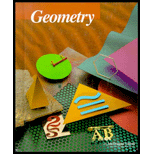
To compare the ratio to the golden ratio calculated in exercise 2 on page 253 and find whether there is a connection.
Explanation of Solution
Given:
The sequence
Calculation:
The first two numbers for the new sequence are 3 and 11.
Hence the modified Fibonacci sequence will be
The following computer program computes the first 25 terms of the modified Fibonacci sequence shown above and finds the ratio of any term to its preceding term.
Let A, B, N, D, E, F, G and C be the variables used in program. Where A and B stand for the first two numbers in the sequence, N stands for the number of terms, D, E, F and G are used to find the ratio up to four decimal places, C stands for the next term in the sequence which is actually the sum of A and B. Consider the program below
Program:
'Print this statement "TERM NO. TERM RATIO" on output screen.
10 PRINT "TERM NO.", "TERM", "RATIO"
'Assign the first two terms to A and B
20 LET A=3
30 LET B=11
40 PRINT “1”, A,”-“
50 FOR N=2 TO 25
60 LET D=B/A
70 LET E=10000
80 LET F=INT (E)
90 LET G=F/10000
100 PRINT N, B, G
110 LET C=B+A
120 LET A=B
130 LET B=C
140 NEXT N
'End of Program
150 END
Sample Output:
TERM NO. TERM RATIO
1 3 -
2 11 3.6666
3 14 1.2727
4 25 1.7857
5 39 1.56
6 64 1.641
7 103 1.6093
8 167 1.6213
9 270 1.6167
10 437 1.6185
11 707 1.6178
12 1144 1.6181
13 1851 1.618
14 2995 1.618
15 4846 1.618
16 7841 1.618
17 12687 1.618
18 20528 1.618
19 33215 1.618
20 53743 1.618
21 86958 1.618
22 140701 1.618
23 227659 1.618
24 368360 1.618
25 596019 1.618
Output Explanation:
Print the heading line for the table
TERM NO. TERM RATIO
Print the first term in the Fibonacci sequence
1 3 -
Print the remaining terms starting from term number 2 to term number 25
2 11 3.6666
3 14 1.2727
4 25 1.7857
5 39 1.56
6 64 1.641
7 103 1.6093
8 167 1.6213
9 270 1.6167
10 437 1.6185
11 707 1.6178
12 1144 1.6181
13 1851 1.618
14 2995 1.618
15 4846 1.618
16 7841 1.618
17 12687 1.618
18 20528 1.618
19 33215 1.618
20 53743 1.618
21 86958 1.618
22 140701 1.618
23 227659 1.618
24 368360 1.618
25 596019 1.618
The golden ratio calculated in the previous program was
The golden ratio computed in this exercise also is
Hence the ratio computed is similar to the given ratio.
Chapter 7 Solutions
McDougal Littell Jurgensen Geometry: Student Edition Geometry
Additional Math Textbook Solutions
Elementary Statistics
College Algebra (7th Edition)
A Problem Solving Approach To Mathematics For Elementary School Teachers (13th Edition)
Calculus for Business, Economics, Life Sciences, and Social Sciences (14th Edition)
Calculus: Early Transcendentals (2nd Edition)
Algebra and Trigonometry (6th Edition)
 Elementary Geometry For College Students, 7eGeometryISBN:9781337614085Author:Alexander, Daniel C.; Koeberlein, Geralyn M.Publisher:Cengage,
Elementary Geometry For College Students, 7eGeometryISBN:9781337614085Author:Alexander, Daniel C.; Koeberlein, Geralyn M.Publisher:Cengage, Elementary Geometry for College StudentsGeometryISBN:9781285195698Author:Daniel C. Alexander, Geralyn M. KoeberleinPublisher:Cengage Learning
Elementary Geometry for College StudentsGeometryISBN:9781285195698Author:Daniel C. Alexander, Geralyn M. KoeberleinPublisher:Cengage Learning

